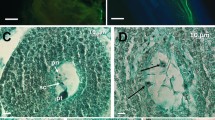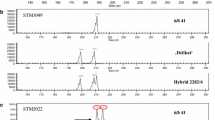Summary
Asymmetric somatic hybrids of Lycopersicon esculentum and Lycopersicon peruvianum were obtained by fusion of leaf protoplasts from both species after irradiation of protoplasts or leaf tissue of L. peruvianum with 50, 300, or 1,000 Gy of gamma-rays. These radiation doses were sufficient to abolish the growth of the L. peruvianum protoplasts. The hybrids were selected for their ability to regenerate plants; this regeneration capacity derived from L. peruvianum. All asymmetric hybrid plants were aneuploid. The ploidy level, the morphology, and the regeneration rate were analyzed in relation to the radiation dose applied to L. peruvianum. After a low dose (50 Gy), most hybrids had near-triploid chromosome numbers, whereas after a high dose (300 or 1,000 Gy), most hybrids had near-pentaploid numbers. The morphology of the asymmetric hybrids was intermediate between that of L. esculentum and symmetric somatic hybrids of both species (obtained without irradiation treatment), and approached the morphology of L. esculentum to a greater extent after a high dose of irradiation. The asymmetric hybrids regenerated more slowly than the symmetric hybrids and regeneration proceeded more slowly after a high dose than after a low dose of irradiation. The high-dose hybrids also grew more slowly, flowered less, and set fruits less than the low-dose hybrids. No seeds could be obtained from any asymmetric hybrid.
Similar content being viewed by others
References
Bates GW, Hasenkampf CA, Contolini CL, Piastuch WC (1987) Asymmetric hybridization in Nicotiana by fusion of irradiated protoplasts. Theor Appl Genet 74:718–726
Cowell JK (1982) Double minutes and homogeneously staining regions: gene amplification in mammalian cells. Annu Rev Genet 16:21–59
Dudits D, Maroy E, Praznovszky T, Olah Z, Gyorgyey J, Cella R (1987) Transfer of resistance traits from carrot into tobacco by asymmetric somatic hybridization: regeneration offer tile plants. Proc Natl Acad Sci USA 84:8434–8438
Famelaer I, Gleba YY, Sidorov VA, Kaleda VA, Parakonny AS, Boryshuk NV, Cherup NN, Negrutiu I, Jacobs M (1989) Intrageneric asymmetric hybrids between Nicotiana plumbaginifolia and Nicotiana sylvestris obtained by “gamma-fusion.” Plant Sci 61:105–117
Gleba YY, Hinnisdaels S, Sidorov VA, Kaleda VA, Parokonny AS, Boryshuk NV, Cherup NN, Negrutiu I, Jacobs M (1988) Intergeneric asymmetric hybrids between Nicotiana plumbaginifolia and Atropa belladonna obtained by “gamma fusion.” Theor Appl Genet 76:760–766
Gupta PP, Schieder O, Gupta M (1984) Intergeneric nuclear gene transfer between somatically and sexually incompatible plants through asymmetric protoplast fusion. Mol Gen Genet 197:30–35
Györffy B, Mako J (1963) Two aneuploid progenies from a sesquidiploid tomato hybrid after uncontrolled pollinations. TGC Rep 13:36–37
Koornneef M, Hanhart CJ, Martinelli L (1987a) A genetic analysis of cell culture traits in tomato. Theor Appl Genet 74:633–641
Koornneef M, Jongsma M, Weide R, Zabel P, Hille J (1987b) Transformation of tomato. In: Nevins DJ, Jones RA (eds) Tomato biotechnology. Alan R Liss, New York, pp 169–178
Menczel L, Nagy F, Kiss ZR, Maliga P (1981) Streptomycin-resistant and sensitive somatic hybrids of Nicotiana tabacum + Nicotiana knightiana: correlation of resistance to N. tabacum plastids. Theor Appl Genet 59:191–195
Murashige T, Skoog F (1962) A revised medium for rapid growth and bioassays with tobacco tissue cultures. Physiol Plant 15:473–497
Negrutiu I, De Brouwer D, Watts JW, Sidorov VI, Dirks R, Jacobs M (1986) Fusion of plant protoplasts: a study using auxotrophic mutants of Nicotiana plumbaginifolia Viviani. Theor Appl Genet 72:279–286
Pijnacker LP, Ferwerda MA, Puite KJ, Schaart JG (1989) Chromosome elimination and mutation in tetraploid somatic hybrids of Solanum tuberosum and Solanum phureja. Plant Cell Rep 8:82–85
Rick CM (1982a) The potential of exotic germ plasm for tomato improvement. In: Vasil IK, Scowcroft WR, Frey KJ (eds) Plant improvement and somatic cell genetics. Academic Press, New York, pp 1–28
Rick CM (1982b) Stock list. Tomato Genet Coop Rep 32:3–10
Rick CM, Butler L (1956) Cytogenetics of the tomato. Adv Genet 8:267–382
Rick CM, Notani NK (1961) The tolerance of extra chromosomes by primitive tomatoes. Genetics 46:1231–1235
Soost RK (1958) Progenies from sesquidiploid F1 hybrids of Lycopersicon esculentum and L. peruvianum. J Hered 49:208–213
Taylor IB (1986) Biosystematics of the tomato. In: Atherton JG, Rudich J (eds) The tomato crop. A scientific basis for improvement. Chapman and Hall, London New York, pp 1–34
Tewes A, Glund K, Walther R, Reinbothe H (1984) High yield isolation and rapid recovery of protoplasts from suspension cultures of tomato (Lycopersicon esculentum). Z Pflanzenphysiol 113:141–150
Wijbrandi J, van Capelle W, Hanhart CJ, van Loenen Martinet-Schuringa EP, Koornneef M (1990a) Selection and characterization of somatic hybrids between Lycopersicon esculentum and Lycopersicon peruvianum. Plant Sci (in press)
Wijbrandi J, Zabel P, Koornneef M (1990b) RFLP analysis of somatic hybrids between Lycopersicon esculentum and irradiated L. peruvianum: evidence for limited donor genome elimination and extensive chromosome rearrangements. Mol Gen Genet (in press)
Wijbrandi J, Wolters AMA, Koornneef M (1990c) Asymmetric somatic hybrids between Lycopersicon esculentum and irradiated Lycopersicon peruvianum 2. Analysis with marker genes Theor Appl Genet (in press)
Yamashita Y, Terada R, Nishibayashi S, Shimamoto K (1989) Asymmetric somatic hybrids of Brassica: partial transfer of B. campestris genome into B. oleracea by cell fusion. Theor Appl Genet 77:189–194
Author information
Authors and Affiliations
Additional information
Communicated by I. Potrykus
Rights and permissions
About this article
Cite this article
Wijbrandi, J., Posthuma, A., Kok, J.M. et al. Asymmetric somatic hybrids between Lycopersicon esculentum and irradiated Lycopersicon peruvianum . Theoret. Appl. Genetics 80, 305–312 (1990). https://doi.org/10.1007/BF00210064
Received:
Accepted:
Issue Date:
DOI: https://doi.org/10.1007/BF00210064




